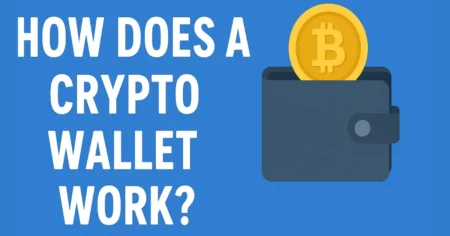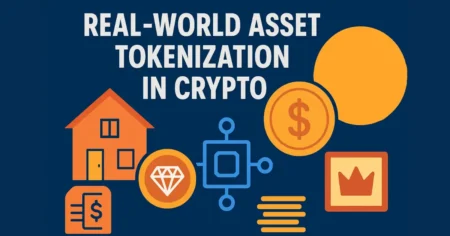Best Crypto Interest Earning Accounts
Introduction to Crypto Interest Accounts
If you’ve ever parked money in a traditional savings account at a U.S. bank, you already understand the basic idea of earning interest. The difference is that with crypto interest accounts, you’re earning on digital assets like Bitcoin, Ethereum, or even stablecoins such as USDC or USDT. These platforms act like banks in one sense—they take your deposits, lend them out, or use them for liquidity purposes, and then pay you interest. But unlike traditional banks, which typically pay less than 1% APY (sometimes even 0.01% at major banks), crypto interest accounts can offer anywhere from 3% to 15% APY or higher depending on the asset and platform.
The rise of these accounts in the U.S. has been fueled by frustration with low bank interest rates, combined with growing trust in cryptocurrencies. Many retail investors are seeking ways to make their crypto holdings work harder instead of just sitting idle in wallets. For example, if you’re holding Bitcoin for the long term, why not earn an extra yield while waiting for the price to grow? That’s where these accounts step in.
However, while they seem appealing, it’s important to know they are not FDIC-insured like traditional bank accounts. This means if the platform fails, your funds may not be protected. That said, many providers implement strong security features, custodianship partnerships, and even limited insurance to boost user trust.
In short, crypto interest accounts combine the world of passive investing with the cutting-edge innovation of blockchain technology. They’re designed for individuals who believe in crypto’s future but also want steady returns along the way.
Benefits of Using Crypto Interest Accounts
Why would someone in the U.S. choose a crypto interest account over just holding coins in a wallet or keeping cash in the bank? The answer lies in the advantages these platforms offer.
- Higher yields compared to banks: Traditional U.S. banks pay dismally low savings interest. In contrast, crypto accounts regularly offer between 5% and 10% APY, sometimes even more. Stablecoins, pegged to the U.S. dollar, often fetch 6% to 12% APY—making them especially appealing for people who want reliable returns without exposure to major volatility.
- Flexibility with digital assets: Unlike CDs (Certificates of Deposit), which lock your funds for years, many crypto accounts allow easy deposits and withdrawals. This means you can move funds in and out as needed, which is ideal for people who want to stay liquid.
- Diversification for investors: If you already invest in stocks, real estate, or bonds, adding crypto interest accounts can diversify your income sources. It’s essentially another asset class producing returns in a different way.
- Passive income opportunities: Not everyone has the time or skill to trade crypto actively. Interest accounts offer a set-it-and-forget-it strategy where you simply deposit and watch your balance grow over time.
Another underappreciated benefit is accessibility. Traditional banks often require high minimum balances for meaningful returns. With crypto platforms, you can start with as little as $10 worth of assets, making it open to a wider range of people.
That said, the high yields are not free of risk. These accounts depend on the health of the lending markets, liquidity pools, and sometimes even third-party borrowers. But for many investors, the reward outweighs the risks.
Risks of Crypto Interest Accounts
As tempting as 10% APYs sound, it’s important to weigh the risks before jumping in. Unlike bank savings accounts in the U.S., crypto interest platforms operate in a relatively new, loosely regulated environment.
- Market volatility: The value of your crypto could drop significantly. Even if you earn interest, the asset itself might lose more in value than you gain. This is especially true for assets like Bitcoin and Ethereum. Stablecoins are less risky here, but they carry their own issues.
- Platform security risks: Hacks and breaches are unfortunately common in crypto. While top platforms implement security measures like multi-signature wallets and cold storage, no system is 100% immune. If a platform is hacked, customer funds could be at risk.
- Regulatory concerns in the USA: The SEC and other regulators have been cracking down on some crypto lending services. For example, Coinbase had to halt its Lend product after regulatory pressure. Future rules could limit or ban certain interest-bearing services.
- Withdrawal limitations: Some platforms impose lock-up periods, meaning you can’t instantly access your funds. Others may freeze withdrawals during liquidity crunches, leaving users frustrated.
One of the biggest lessons comes from the collapse of Celsius Network and Voyager Digital in 2022, where customers lost access to billions of dollars. These events highlight that not all platforms are equal, and due diligence is critical.
In short, crypto interest accounts can be profitable, but they should not be mistaken for risk-free investments. Treat them as part of a diversified portfolio rather than a replacement for insured savings accounts.
How to Choose the Best Crypto Interest Account
With dozens of platforms in the market, picking the right one can feel overwhelming. But if you know what to look for, you can narrow down your options effectively.
- Evaluating interest rates (APY): Don’t just chase the highest advertised rate. Often, platforms offering 20% APY are too risky. Look for sustainable yields in the 5–10% range, especially with stablecoins.
- Supported cryptocurrencies: Some platforms only support major coins like Bitcoin and Ethereum, while others offer 50+ assets. If you want to earn on niche tokens, make sure they’re supported.
- Security measures and insurance: Check whether the platform uses third-party custodians, cold storage, and insurance coverage. For U.S. investors, custodians like Gemini or Fireblocks often indicate a higher level of trust.
- Transparency and reputation of the platform: Look at reviews, user feedback, and how long the company has been in business. Established names like Nexo, Gemini, and Crypto.com are generally safer than unknown startups promising sky-high yields.
Another factor is ease of use. If you’re new, a simple, intuitive app may be more valuable than an advanced but complicated one. U.S.-based customer support is also a bonus.
Doing due diligence is crucial. Remember the old saying: if it sounds too good to be true, it probably is. Stick with platforms that balance competitive yields with strong reputations.
Top Crypto Interest Earning Accounts in 2025
Now that we’ve covered the basics, let’s look at some of the best options available in 2025 for U.S. investors.
- Nexo: Known for strong security and daily payouts. Offers up to 12% APY on stablecoins and 8% on Bitcoin. Insurance coverage adds extra peace of mind.
- Crypto.com Earn: Wide selection of assets and flexible lock-up options. APYs range from 4% to 12% depending on the coin and staking of CRO tokens.
- Coinbase Earn: While not offering the highest rates, it’s one of the safest options regulated in the U.S. Perfect for beginners who prioritize trust over yield.
- Binance Earn: More suitable for experienced users. Offers multiple earning options, from flexible savings to locked staking. APYs vary widely, sometimes exceeding 10%.
- Gemini Earn: A U.S.-regulated option with a strong reputation. Supports a wide range of assets with APYs averaging 3% to 8%.
- Other rising platforms: New entrants continue to shake up the market. Watch for platforms like YouHodler and BlockFi (if regulatory issues settle) as they expand offerings.
Each of these platforms has its strengths. For beginners, Coinbase or Gemini may be safest. For higher yields, Nexo and Crypto.com often deliver. Advanced users who don’t mind complexity might prefer Binance.
Comparing Crypto Interest Platforms
When evaluating crypto interest platforms in 2025, it helps to see them side by side. Each platform offers unique advantages, and the “best” choice often depends on your goals. Some investors want the highest APY, while others prioritize security, regulatory compliance, or flexibility in accessing funds.
Let’s break down the main contenders:
| Platform | Supported Assets | APY Range | Payout Frequency | Best For |
|---|---|---|---|---|
| Nexo | 40+ assets | 5%–12% | Daily | Stablecoin holders, passive investors |
| Crypto.com | 50+ assets | 4%–12% | Weekly | Investors willing to stake CRO for higher yields |
| Coinbase | Limited (BTC, ETH, USDC) | 1.5%–5% | Monthly | Beginners, U.S. residents seeking regulatory safety |
| Binance Earn | 100+ assets | 1%–15% | Flexible/varied | Advanced users, global investors |
| Gemini Earn | 40+ assets | 3%–8% | Daily | U.S. users valuing regulation and reliability |
If you’re new, Coinbase and Gemini stand out because they operate under stricter U.S. regulations. While their APYs are lower than some global competitors, they offer a sense of security. On the other hand, Nexo and Crypto.com provide better yields, especially for stablecoins, but they may involve more complexity, such as staking native tokens or committing funds for longer periods.
For more seasoned investors, Binance Earn offers the widest range of options—from flexible savings to locked staking programs. But Binance has also faced regulatory hurdles in the U.S., which may concern some investors.
In short, no one platform is universally “best.” Instead, the right choice depends on whether you value yield, flexibility, or security most. Many savvy investors even split funds across multiple platforms to balance risk and reward.
How Interest is Paid on Crypto Accounts
Understanding how interest works is key to setting realistic expectations. Unlike traditional bank savings accounts that pay monthly, crypto interest accounts often provide more flexible payout options.
- Simple vs. compound interest: Some platforms offer simple interest, meaning your returns are only on the principal. Others allow compounding, where earned interest is reinvested and begins earning more interest over time. Compounding can make a massive difference over the long run.
- Payout schedules: Depending on the platform, you might get daily, weekly, or monthly payouts. Daily payouts, like those from Nexo, are especially attractive since they allow compounding to kick in sooner. Coinbase, on the other hand, typically pays monthly.
- Example calculation: Let’s say you deposit $10,000 in USDC at 10% APY with daily compounding. By the end of the year, you’d earn around $1,050—not just $1,000. Over multiple years, the gap widens as compound growth accelerates.
Some platforms also let you choose whether you want payouts in the same asset or in a stablecoin. For example, earning Bitcoin interest can help you accumulate more BTC without actively buying more.
The key takeaway is this: the frequency and method of payouts directly affect how much you actually earn. If your goal is maximizing growth, platforms with daily compounding and reinvestment options may be your best bet.
Tax Implications in the USA
One of the most overlooked aspects of crypto interest accounts is taxation. The IRS treats crypto interest differently than traditional bank savings, and failing to report properly can lead to penalties.
- IRS rules on crypto earnings: According to IRS guidelines, any interest earned in crypto is considered ordinary income. So, if you earn $1,000 worth of USDC interest, you must report it as income in that tax year.
- Difference between capital gains and interest income: Selling crypto at a profit is treated as a capital gain, while interest is taxable as income the moment you receive it. This distinction is crucial because capital gains may qualify for lower long-term tax rates, but interest does not.
- Best practices for reporting: Many platforms provide annual tax forms (like 1099 forms for U.S. users). However, not all do. To avoid headaches, keep detailed records of your earnings, including the value of payouts at the time they were received.
Some crypto-savvy accountants recommend using tax software integrated with exchanges to automate reporting. This can help you avoid mistakes and save hours of manual tracking.
The bottom line? If you’re earning interest on crypto in the U.S., assume the IRS wants a piece of it. Build taxes into your strategy so you’re not caught off guard come April.
Strategies to Maximize Earnings
Earning high yields on crypto is exciting, but smart investors know that strategy matters as much as picking the right platform. Here are proven ways to maximize your earnings:
- Holding stablecoins for steady returns: Stablecoins like USDC and USDT are pegged to the U.S. dollar, making them less volatile than Bitcoin or Ethereum. Many platforms offer the highest APYs on stablecoins, often in the 8%–12% range. This is a great way to earn without worrying about price crashes.
- Diversifying across platforms: Don’t put all your crypto eggs in one basket. By spreading funds across multiple platforms, you reduce the risk of losing everything if one provider fails. For example, you might split $20,000 across Nexo, Gemini, and Crypto.com.
- Reinvesting earned interest: Compounding is powerful. If you simply withdraw your interest each month, you lose the exponential growth potential. Reinvesting earnings ensures your money keeps working harder.
- Risk management tips: Always consider your liquidity needs. If you might need cash in the short term, avoid locking funds into long-term contracts. Also, keep part of your portfolio in cold storage for safety, rather than having all assets on earning platforms.
Advanced investors sometimes mix strategies—using stablecoins for predictable returns while holding long-term crypto assets like Bitcoin for growth. This hybrid approach balances stability with upside potential.
By being deliberate and disciplined, you can turn crypto interest accounts into a reliable passive income stream instead of just a speculative gamble.
Alternatives to Crypto Interest Accounts
If crypto interest accounts don’t feel like the right fit, there are other ways to earn on your digital assets. These options often carry different risks and rewards:
- Staking cryptocurrencies: Many proof-of-stake blockchains, like Ethereum, Solana, or Cardano, allow you to stake coins and earn rewards for helping secure the network. Yields typically range from 4% to 12%, depending on the asset.
- Yield farming in DeFi: For those comfortable with decentralized finance (DeFi), yield farming involves providing liquidity to decentralized exchanges or lending pools in return for rewards. Yields can be much higher than centralized platforms—but so are the risks, including smart contract bugs and impermanent loss.
- Lending platforms vs. exchanges: Beyond big names like Coinbase and Gemini, there are specialized lending platforms where you can directly lend your crypto to other users. These can provide higher returns but also come with more counterparty risk.
Each alternative has its place. Staking is ideal for long-term holders who believe in a particular blockchain’s future. Yield farming attracts high-risk, high-reward seekers. Lending platforms provide more control but require careful due diligence.
In the end, whether you stick with interest accounts or explore alternatives depends on your risk tolerance and investment goals. Many U.S. investors use a mix of strategies to capture both safety and growth.
Real User Experiences & Case Studies
The best way to understand the value—and risks—of crypto interest accounts is by looking at real user experiences. Across the U.S., investors ranging from small savers to high-net-worth individuals have tested the waters, with mixed but insightful outcomes.
- Small investor perspective: Take the example of a college student in California who decided to deposit $2,000 in USDC on Nexo at 10% APY. Over the course of a year, the student earned around $200 in interest—money that might otherwise have sat idle in a checking account earning virtually nothing. While the return wasn’t life-changing, it was a meaningful introduction to the concept of passive crypto income.
- High-net-worth investor perspective: On the other end of the spectrum, a New York investor placed $100,000 in stablecoins across three different platforms—Gemini, Nexo, and Crypto.com. By diversifying across multiple providers, the investor minimized exposure to a single point of failure. At an average 8% APY, this strategy generated roughly $8,000 in passive income in a year—comparable to rent from a small investment property, but with far less hassle.
- Lessons from past collapses: Unfortunately, not all stories are positive. In 2022, the collapse of Celsius Network and Voyager left thousands of U.S. investors unable to access funds. Many users reported losing life savings by chasing the highest yields without considering platform safety. These painful lessons reinforced the importance of due diligence and diversification.
The key takeaway is this: real experiences prove that crypto interest accounts can indeed deliver steady passive income, but they also highlight the risks of putting too much trust in unproven platforms. Successful users tend to follow a balanced approach—earning attractive yields while still protecting their principal.
Future of Crypto Interest Accounts in the USA
Looking ahead, the future of crypto interest accounts in the U.S. will be shaped by three powerful forces: regulation, competition, and mainstream adoption.
- Impact of regulations: The SEC and other regulators are increasingly scrutinizing crypto lending and interest-bearing products. While this may initially restrict certain services, in the long run, clearer rules could boost investor confidence. Expect to see platforms adjust by registering with U.S. regulators or partnering with licensed financial institutions.
- Growing competition among platforms: As demand grows, more players are entering the market. Established exchanges like Coinbase and Gemini are refining their products, while global competitors like Binance and Nexo push for market share. This competition should drive innovation—potentially leading to higher yields, better security, and more user-friendly platforms.
- Adoption by traditional banks: Don’t be surprised if traditional U.S. banks eventually offer crypto interest accounts directly. Already, some regional banks are exploring partnerships with crypto custodians. In the next five years, we may see hybrid accounts that allow customers to earn on both fiat and crypto assets within the same institution.
In essence, the future looks promising, but also dynamic. Investors who stay informed and adapt to regulatory and market shifts will be best positioned to benefit.
Expert Tips for Beginners
If you’re just starting out with crypto interest accounts, diving in blindly can be risky. Here are some expert tips to help you navigate safely:
- Start small and learn gradually: Begin with an amount you’re comfortable losing, even if it’s just $100. This way, you can test how the platform works without taking on major risk.
- Avoid scams and unsafe platforms: Be wary of platforms that promise unusually high APYs (like 20%+). These often operate unsustainably and may collapse. Stick to well-reviewed, reputable names with transparent business models.
- Understand liquidity needs: Don’t lock up funds you may need for emergencies. If your platform requires a 3-month hold, make sure you won’t need that money in the meantime.
- Research security measures: Look for platforms that use cold storage, two-factor authentication, and third-party custodians. U.S.-regulated platforms like Gemini and Coinbase are generally safer choices for beginners.
The most important rule is patience. Many successful investors didn’t start with thousands of dollars. They built confidence over time by starting small, learning how payouts work, and then scaling up once they trusted the system.
Common Mistakes to Avoid
Even seasoned investors sometimes fall into traps when using crypto interest accounts. Avoiding these mistakes can save you from unnecessary losses:
- Chasing the highest APY blindly: Many investors jump on platforms that advertise 15–20% yields without asking how those returns are generated. Often, such models are unsustainable, and when they collapse, users are left empty-handed.
- Ignoring withdrawal restrictions: Some platforms require you to lock up funds for weeks or months. Others may freeze withdrawals during times of stress, leaving you unable to access your money when you need it most.
- Failing to research security measures: If you don’t check whether a platform uses insured custodians or has a track record of handling security breaches, you may be taking unnecessary risks.
- Overexposing your portfolio: Putting your entire crypto stash into a single interest account is a recipe for disaster. Spreading funds across multiple platforms and keeping some assets in cold storage is much safer.
By avoiding these pitfalls, you can focus on steady, sustainable returns rather than chasing short-lived opportunities that may end in regret.
Conclusion
Crypto interest accounts have emerged as one of the most exciting innovations in the financial world. For U.S. investors tired of near-zero bank yields, these platforms offer a way to generate real passive income—sometimes rivaling traditional investments like real estate or dividend stocks.
That said, they are not without risks. Volatility, platform security, and regulatory uncertainty all play a role. The safest path is a balanced one: choose reputable providers, diversify across platforms, favor stablecoins for predictable returns, and never invest more than you can afford to lose.
The future is bright, but it belongs to investors who approach this space with caution, curiosity, and discipline. With the right strategy, crypto interest accounts can become a powerful tool in your financial toolkit.
FAQs
Are crypto interest accounts safe in the USA?
They can be relatively safe if you stick to regulated platforms like Gemini and Coinbase. However, they are not FDIC-insured, so risks remain.
Which crypto gives the best interest rates?
Stablecoins like USDC and USDT often offer the highest yields—typically 8%–12%—because they are widely used for lending and liquidity.
Can I lose money in a crypto interest account?
Yes. Market volatility, platform failures, and regulatory actions can all lead to losses. Always diversify and use caution.
How often is interest paid?
It depends on the platform. Some pay daily (Nexo, Gemini), others weekly (Crypto.com), and some monthly (Coinbase).
Do I need to pay taxes on my crypto interest?
Yes. The IRS considers crypto interest taxable income, and it must be reported on your tax return each year.
Also, read
- What is a crypto wallet, and how does it work? – Coinsify
- 10 Crypto Terms Every Beginner Must Know: Coinsify
- What is blockchain technology? Complete Guide – Coinsify
- How to Buy Crypto Safely in 2025: Complete Guide – Coinsify
- Bitcoin vs Ethereum: Key Differences Explained: Complete Guide
- Ultimate Blockchain Glossary: Learn Blockchain Terms Easily
- How to Buy Bitcoin Safely (Complete Beginner’s Guide)
- Top 10 Crypto Wallets for Beginners (2025 Edition)
- What is cryptocurrency? A Beginner-Friendly Guide (2025)






